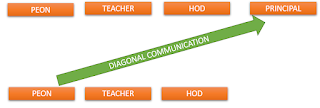LEVELS OF
COMMUNICATION
We live in society and being a
social animal, we need to talk to various people to satisfy our needs. Sometime
we talk to either ourselves or animals or to others for satisfying our needs.
It means we talk for different people on different levels. There are five
levels of communication.
1. Extra personal:
-Communication between human beings and non-human entities is called extra
personal communication. This form of communication requires more perfect
co-ordination and understanding between the sender and the receiver. At least
one of them either transmits information or responds in sign language. When you
return from your office your dog comes to you and wage his tail. You
immediately grab him in your arms and start talking to him and he responds in
sign language but you understand and communication goes on.
2. Intra personal: - this
takes place within the individual. The brain of a person is linked to all the
parts of the body by an electrochemical system. Any organ behaves like sender,
electrochemical impulse is message and the brain is receiver and then brain
acts as sender and sends feed back to the organ which bow acts as receiver.
This communication pertains to thinking self-motivation, self-determination etc.
lake place at the intra-personal level.
3. Interpersonal: - In
this level sharing of information among people is started. It differs from
other forms of communication in the way that at least two people are involved
in it. The speaker and the listener are in close physical proximity to each
other, there are no sensory channels are used and feedback is immediate. It is
advantageous as feedback is direct and immediate. Nonverbal plays a major role
in this communication due to proximity of the people involved. This
communication can be formal or informal. Interpersonal communication situations
depend on a variety of factors: - psychology of two parties, relationship
between them, situation, environment and cultural context. Whenever both the
parties have some common frame of reference, background, purpose and interest
they have relevant interaction. If anyone party is not interested, no
communication takes place. If a person is instructing to his junior and he
understands the thing and responds accordingly it means the interpersonal
communication is effective and fruitful.
4. Organizational
communication: - This type of communication takes
place in an organization at different hierarchical levels. It makes the
functioning of an organization smooth. It plays an important role in the growth
of organization. The different hierarchical levels are
a) Internal-operational: - It helps in conducting smooth functioning within an organization.
b) External-operational: - It helps in making communication outside the organization for a specific purpose.
c) Personal: - Communication that occurs among the workforce without a purpose related to business or job is called personal (organizational) communication.
5. Mass communication: - The communication through which we can spread our message to a large number of audiences at one time is called mass communication. Either a person or an organization or a group acts as sender and a number of people are there at the receiver end. In this type of communication, we require a mediator to transmit the information. There are several example of mass media such as journals, books, television and newspapers. A
ll these media mediate such communication.
This is more persuasive than any other form of communication. It requires
utmost care on the part of the sender in encoding the message. Some equipment
are required in oral communication and print or visual media.
Its main characteristics are
a) Large
reach: -It has large reach as one person can send his
message to countless people at a time.
b) Impersonal: -Mass
communication is impersonal in its services. It delivers the message to all
without biasness.
c) Presence
of gate keeper: - Mass communication needs additional persons,
institutions or organization to convey the message. Gate keeper may be a person
or active group. Example editor is the gate keeper in the mass
communication.












